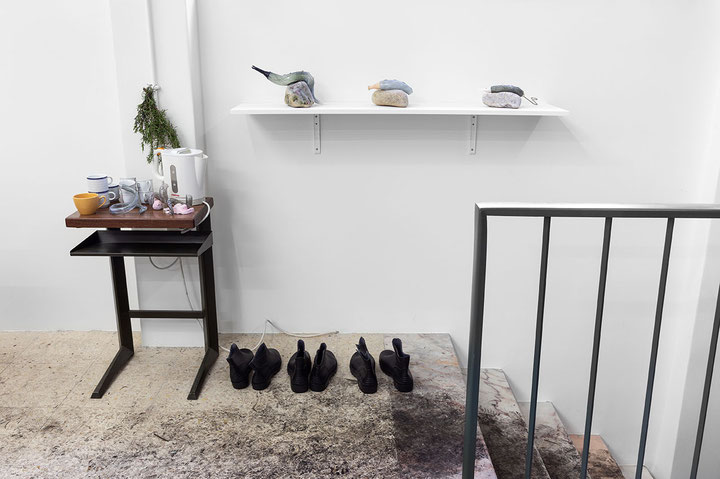Lisbon. I first encountered the works of Laure Prouvost during The School of Kyiv in 2015, a biennale that hosted contemporary art in socialist modernist buildings. The route to the exhibition led across a slope covered in wild vegetation dividing upper and lower parts of the city. Coming down the crumbling concrete staircases through a thicket of ferns, I found myself in the garage cooperative where one of the units was used by the Visual Culture Research Center as an exhibition space. In the garage, the long dark corridor led to the video installation Into all that is here (2015), pulsating with rapid montage, an excess of color, and intense whispering. The video investigates lust, desire, and emotion through the splendor of vegetative and bodily experiences, warmth and moisture.
Laure Prouvost often makes the environment resonate with her art in a very special way as the constellation of objects she presents melts into the environment. The space becomes immersive, ambient, untamed. Whether a forest, a pit house, or the French Pavilion in the Giardini at the Venice Biennale, she subverts and plays with the space, finding unused and hidden rooms and changing exits and entrances and other common functionalities. She occupied the basement space of the Kunsthalle Lissabon, a not-for-profit contemporary art space in the port area of the city, in a similar way. The Kunsthalle celebrated its tenth anniversary in 2019 by suspending its activities and exhibitions and disappearing from the cultural field for a year. The organizers published a manifesto on the problematic cultural policies in a rapidly gentrifying city. The institution has now reopened with the Prouvost show, which fits in very well with the contemporary moment of precarity and instability shared by institutions, subjectivities, and materialities. The journey the artist takes us on perhaps started in the waters of Venice, with her pavilion “Deep See Blue Surrounding You” representing France in 2019. It features the city’s dark side: a cave, a cavity, a dungeon.
There is a line of rubber boots to wear and glass objects reminiscent of musical instruments or mollusks in front of the staircase that leads down to the basement. Once you have descended, the darkness prevents you from seeing anything. You may want to make use of your cell-phone flashlight. The marble floor is covered with water, mud, and objects. At first glance, it calls to mind a primordial soup, nebulous and mysterious liquid where life has emerged. Later, once your eyes get used to the dark, you can recognize ready-made and custom-built artifacts emerging from the indeterminate mass: cigarette butts and glass shapes, ceramic objects, broken iPhone screens and piles of books – all melting into one ecosystem. The space is divided by black curtains, creating several smaller rooms that gently help visitors navigate until their eyes have adjusted to the dark. Silhouettes of objects become visible by the light of videos: one projected directly onto the watery floor and another displayed on a small broken smartphone screen. Some of the curtains are pinned up with oblong glass objects recalling tentacles. This immersive space gives the impression of a nocturnal deep-time landscape. The whispering voice from the video takes you even deeper, to a pre-linguistic realm of experience.
This was the last exhibition I visited before the lockdown. Most of the art institutions across Europe were closed to protect their visitors from contagion. What happens when the exhibition is closed? Video and sound are switched off, but the nutritious mix of mud, water, and warmth maintains its own life even without viewers; it has its own temporality beyond the opening hours and the curfew, generating encounters between art objects, matter, and bacteria in total darkness. Donna Haraway speaks of the prosperous state of co-living, calling it “Chthulucene”: “My’ Chthulucene [...] entangles myriad temporalities and spatialities and myriad intra-active entities-in-assemblages – including the more-than-human, other-than-human, inhuman, and human-as-humus.”1 The strange and playful ecosystem of regeneration and circulation that Laura Prouvost has created can operate in a similar way: it connects, lubricates, contaminates, and does not always need a human viewer.
[1] Donna Haraway. “Anthropocene, Capitalocene, Plantationocene, Chthulucene: Making Kin,” in Environmental Humanities, vol. 6, 2015, pp. 159–165, here p. 160.
